Abraxas is a word of mystic meaning in the system of the Gnostic Basilides, being there applied to the "Great Archon", the princeps of the 365 spheres. The word is found in Gnostic texts such as the Holy Book of the Great Invisible Spirit, and also appears in the Greek Magical Papyri. It was engraved on certain antique gemstones, called on that account Abraxas stones, which were used as amulets or charms. As the initial spelling on stones was Abrasax (Αβρασαξ), the spelling of Abraxas seen today probably originates in the confusion made between the Greek letters sigma (Σ) and xi (Ξ) in the Latin transliteration.

A demon is a malevolent supernatural entity. Historically, belief in demons, or stories about demons, occurs in folklore, mythology, religion, and literature; these beliefs are reflected in media including comics, fiction, film, television, and video games. Belief in demons probably goes back to the Paleolithic age, stemming from humanity's fear of the unknown, the strange and the horrific. In ancient Near Eastern religions and in the Abrahamic religions, including early Judaism and ancient-medieval Christian demonology, a demon is considered a harmful spiritual entity that may cause demonic possession, calling for an exorcism. Large portions of Jewish demonology, a key influence on Christianity and Islam, originated from a later form of Zoroastrianism, and was transferred to Judaism during the Persian era.
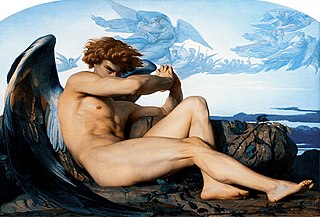
The most common meaning for Lucifer in English is as a name for the Devil in Christian theology. It appeared in the King James Version of the Bible in Isaiah and before that in the Vulgate, not as the name of a devil but as the Latin word lucifer (uncapitalized), meaning "the morning star", "the planet Venus", or, as an adjective, "light-bringing". It is a translation of the Hebrew word הֵילֵל, hêlēl, meaning "Shining One".
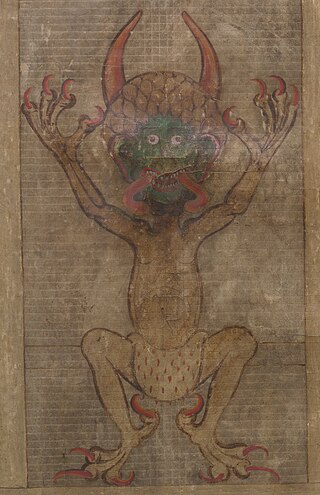
Satan, also known as the Devil, is an entity in Abrahamic religions that seduces humans into sin or falsehood. In Judaism, Satan is seen as an agent subservient to God, typically regarded as a metaphor for the yetzer hara, or "evil inclination". In Christianity and Islam, he is usually seen as a fallen angel or jinn who has rebelled against God, who nevertheless allows him temporary power over the fallen world and a host of demons. In the Quran, Shaitan, also known as Iblis, is an entity made of fire who was cast out of Heaven because he refused to bow before the newly created Adam and incites humans to sin by infecting their minds with waswās.

Mammon in the New Testament is commonly thought to mean money, material wealth, or any entity that promises wealth, and is associated with the greedy pursuit of gain. The Gospel of Matthew and the Gospel of Luke both quote Jesus using the word in a phrase often rendered in English as "You cannot serve both God and mammon."
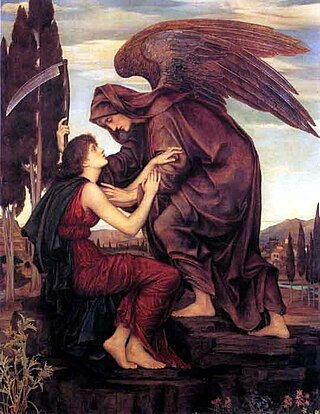
Samael is an archangel in Talmudic and post-Talmudic lore; a figure who is the accuser or adversary, seducer, and destroying angel.

Bael is a demon described in demonological grimoires such as The Lesser Key of Solomon and the Pseudomonarchia Daemonum and also in the Dictionnaire Infernal. He is described as a hoarsely-voiced king with the power to make men invisible and ruling over sixty-six legions of demons. The Lesser Key of Solomon describes him as appearing in the form of a cat, toad, human, some combination thereof, or other "diverse shapes", while the Pseudomonarchia Daemonum and the Dictionnaire Infernal state that he appears with the heads of a cat, toad, and human simultaneously.
Vine is a demon listed in demonological grimoires such the Lesser Key of Solomon Johann Weyer's Pseudomonarchia Daemonum, and Jacques Collin de Plancy's Dictionnaire Infernal.
Lerajie is a mighty Great Marquis of Hell who has thirty-three legions of Demons under his power. He is said to cause great battles and disputes, and makes gangrene wounds caused by arrows. He can make a lover come to him, and also send them away. He is depicted as a gallant and handsome archer clad in green, carrying a bow and quiver, in the folklore of the Bible. But his true appearance is around 5 feet tall, with shoulder length black hair and bangs. With a long shimmering red wingspan. Leraje is a demon mentioned in demonological grimoires. He appears in the Lesser Key of Solomon, Johann Weyer's Pseudomonarchia Daemonum, and Jacques Collin de Plancy's Dictionnaire Infernal.

Christian demonology is the study of demons from a Christian point of view. It is primarily based on the Bible, the interpretation of these scriptures, the writings of early Christianity philosophers, hermits, and the associated traditions and legends incorporated from other beliefs.

There have been various attempts at the classification of demons within the contexts of classical mythology, demonology, occultism, and Renaissance magic. These classifications may be for purposes of traditional medicine, exorcisms, ceremonial magic, witch-hunts, lessons in morality, folklore, religious ritual, or combinations thereof. Classifications might be according to astrological connections, elemental forms, noble titles, or parallels to the angelic hierarchy; or by association with particular sins, diseases, and other calamities; or by what angel or saint opposes them.

Fallen angels are angels who were expelled from Heaven. The literal term "fallen angel" does not appear in any Abrahamic religious texts, but is used to describe angels cast out of heaven or angels who sinned. Such angels often tempt humans to sin.

Demon: The Fallen is a 2002 tabletop role-playing game released by White Wolf Publishing. Set in the World of Darkness, players take on the role of a demon - a fallen angel who descended to the Garden of Eden with Lucifer, only to be condemned to Hell after a long war with Heaven. The game focuses on "infernal glory" as its central theme for storytelling and character development - the acquisition of power to restore the Fallen's grace as well as to potentially reconnect with humanity, all the while staving off their own agony and evading monstrous demons.
A devil, also referred to as a baatezu, is a group of fictional creatures in the Dungeons & Dragons (D&D) roleplaying game typically presented as formidable opponents for advanced players. Devils are characterized by their Lawful Evil alignment and are depicted as originating from the Nine Hells of Baator. They follow a strict and hierarchical structure, progressing through various forms as they rise in rank. At the top of this hierarchy are the Archdevils, also known as the Lords of the Nine, who govern different regions within Baator. Devils are often portrayed as seeing the various worlds in the D&D universe as tools to be exploited for their objectives, such as participating in the Blood War—a centuries-long conflict against demons.

In Christianity, the Devil is the personification of evil. He is traditionally held to have rebelled against God in an attempt to become equal to God himself. He is depicted as a fallen angel, who was expelled from Heaven at the beginning of time, before God created the material world, and is in constant opposition to God. The devil is conjectured to be several other figures in the Bible including the serpent in the Garden of Eden, Lucifer, Satan, the tempter of the Gospels, Leviathan, and the dragon in the Book of Revelation.

The Dictionnaire Infernal is a book on demonology, describing demons organised in hierarchies. It was written by Jacques Collin de Plancy and first published in 1818. There were several editions of the book; perhaps the most famous is the 1863 edition, which included sixty-nine illustrations by Louis Le Breton depicting the appearances of several of the demons. Many but not all of these images were later used in S. L. MacGregor Mathers's edition of The Lesser Key of Solomon.

Leonard or Master Leonard is a demon or spirit in the Dictionnaire Infernal, grand-master of the nocturnal orgies of demons. He is represented as a three-horned goat, with a black human face. He marks his initiates with one of his horns. Infernal powers obtained from the worship of Master Leonard range from metamorphosis into monstrous animals or men to flight as an incubus.

Beelzebub or Baʿal Zebub, also spelled Beelzebul or Belzebuth, and occasionally known as the Lord of the Flies, is a name derived from a Philistine god, formerly worshipped in Ekron. In some Abrahamic religions he is described as a major demon. The name Beelzebub is associated with the Canaanite god Baal.
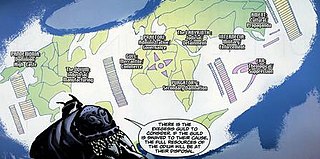
Hell is a fictional location, an infernal Underworld utilized in various American comic book stories published by DC Comics. It is the locational antithesis of the Silver City in Heaven. The DC Comics location known as Hell is heavily based on its depiction in Abrahamic mythology. Although several versions of Hell had briefly appeared in other DC Comics publications in the past, the official DC Comics concept of Hell was first properly established when it was mentioned in The Saga of the Swamp Thing #25–27 and was first seen in Swamp Thing Annual #2 (1985), all of which were written by Alan Moore and illustrated by Stephen Bissette and John Totleben.
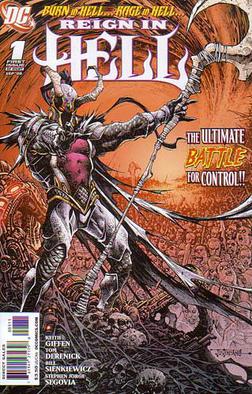
Reign in Hell is a 2008-2009 comic book miniseries written by Keith Giffen, pencilled by Thomas Derenick, inked by Bill Sienkiewicz and published by DC Comics. The title is a reference to a line spoken by Lucifer in John Milton's epic poem Paradise Lost: "Better to reign in Hell than serve in Heaven".















